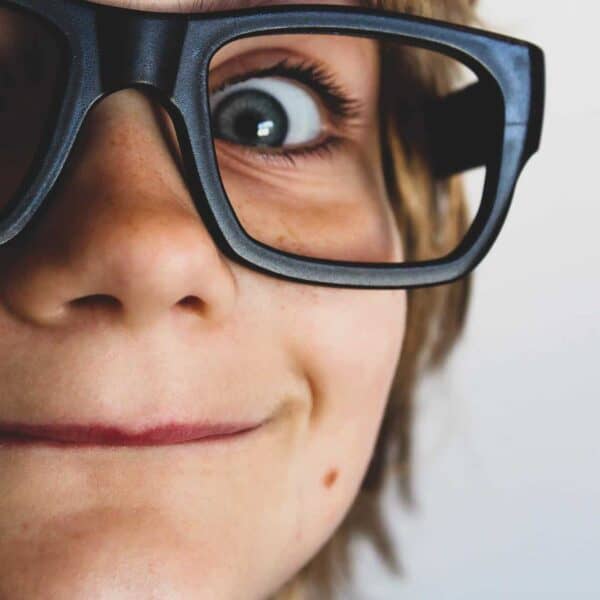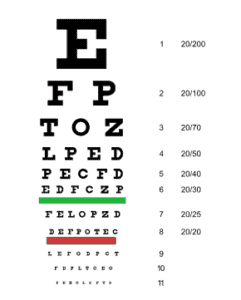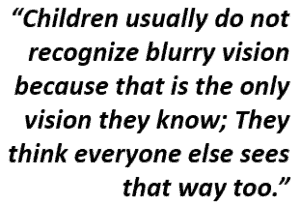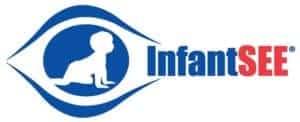
Why Vision Screenings Are Not Enough
February 14, 2019


“Stand at the end of the hallway and cover an eye.”
Whether at school or the pediatrician’s office, we have all heard these words during a vision screening. While vision screenings can detect big problems with vision, they don’t even scratch the surface of detectable conditions diagnosed in a comprehensive eye exam.
Who needs an eye exam? Everyone. ESPECIALLY YOUR LITTLE ONES!
We’re here to clarify the popular misconception that a vision screening is equivalent to an eye exam. Similarly to a dentist visit, your children might not have tooth decay, but you still take them to get their teeth cleaned one to two times per year. We are only given one set of eyes, so we want to protect vision and ocular health!
When should my child have their first eye exam?
According to the American Optometric Association (AOA), a child’s first eye exam is recommended between 6 to 12 months of age. If there is a low risk of developing eye or vision problems, the child should be seen again at least once between 3 to 5 years of age, before first grade, and annually thereafter. If the child is at a high risk for developing eye or vision problems, the eye doctor will determine the appropriate follow-up time based on the situation.

Between the ages of birth to 6 years old, the eyes are developing at a rapid pace. Any constant and significant disturbance to the eyes during this time can lead to amblyopia (a condition in which the best corrected vision is worse than 20/20 in either one or both eyes due to poor development during childhood). Children usually do not recognize blurry vision because that is the only vision they know; They think everyone else sees that way too. A comprehensive eye exam allows an eye care professional to ensure normal development of vision, eye alignment, and overall ocular health.

Why does my child need an eye exam if they had a vision screening at the pediatrician’s office?
A vision screening is not a substitute for a comprehensive eye exam. Testing the distance and near vision in a screening will identify children with obvious vision problems, however, many cases are much more subtle than a vision screening is able to detect. If the pediatrician or school nurse is concerned with the screening results, the child will be sent to an eye doctor for further testing, diagnosis, and treatment. As optometrists, we have specialized training, tools, and resources for providing a thorough eye examination.
Hyperopia (farsightedness) can easily be missed during a vision screening if not severe. Unfortunately, even some cases of mild hyperopia can negatively impact a child’s ability to comfortably read at near. As optometrists, we have the necessary resources to detect and prescribe glasses for hyperopia in our office. When a child physically struggles to comfortably see up close, there is an association with difficulty in learning to read. This can ultimately lead to a decline in academics, behavior problems, and lack of attention. Similarly, accurate eye teaming (how well the eyes work together), eye alignment and eye focusing skills also play contributing roles with reading. A child’s ability to learn can be greatly hindered by a vision or eye health problem.
A vision screening does not examine ocular health. Serious eye conditions that can be diagnosed with a comprehensive, dilated eye exam are not identified in a screening. Many ocular tumors and retinal diseases can only be diagnosed through a dilated examination. We also consider family history of eye conditions as an important component of eye wellness. This alerts us to the risk of potential problems in the future.
Just as the name implies, a vision screening is simply a quick check of vision to determine if a more thorough exam is necessary. While screenings are beneficial for those with minimal access to vision care, they are commonly mistaken as a replacement for a full eye exam.
What can we expect at my child’s first exam?
We will start with ocular and medical history to discuss any concerns and/or observations from a parent. The contents of the exam will be similar whether a toddler or teenager, however, there are variations based on the child’s age.
– Vision testing
– Color vision and depth perception
– Eye muscles: observe movement and alignment
– Pupils: check reaction to light
– Refraction: determine if glasses are needed
– Tonometry: measure eye pressure
– Ocular health assessment: evaluate eyelids, lashes, cornea, iris, lens
– Dilation: examine retina, blood vessels, optic nerve

You might wonder how reliable a child answers to “Which is better? 1 or 2?” Fortunately for us, we have a tool, called a retinoscope. Using this instrument, we are able to determine an exact glasses prescription without any subjective response from the patient. This is extremely useful when examining infants and young children.
Dr. O’Neal received additional certification for her concentrated studies in pediatrics. She would love to examine your children’s eyes! A vision screening at the pediatrician’s office or school is not equivalent to an exam by an eye doctor. If your children have never had a comprehensive, dilated eye exam (or are due for another), please call our office or schedule an appointment online with Dr. O’Neal.